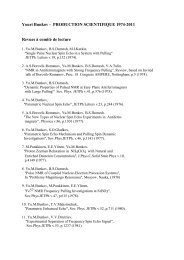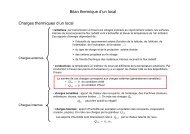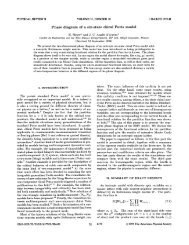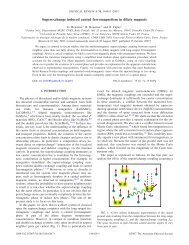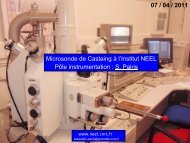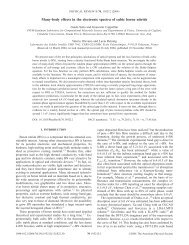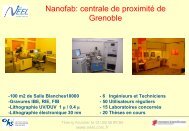Activity Report 2010 - CNRS
Activity Report 2010 - CNRS
Activity Report 2010 - CNRS
Create successful ePaper yourself
Turn your PDF publications into a flip-book with our unique Google optimized e-Paper software.
OVERVIEW<br />
was made operative in only three months<br />
which is an exceptionally short timeframe.<br />
In addition the Steering Committee of<br />
NanoINNOV pays attention to support<br />
programs directed to societal issues:<br />
societal acceptability, science<br />
dissemination,… taking into account the<br />
diversity of publics, using different<br />
approaches to introduce debates with<br />
citizens.<br />
NanoINNOV had a very good start,<br />
fostered in a very short time an effective<br />
strategy and instruments to implement it.<br />
However national issues, (The Grenelle<br />
for Environment, and the GDPN standing<br />
for ‘National Grand Public Debate’) arose<br />
and crashed into this “French NNI”<br />
program.<br />
The GDPN, badly driven, introduced the<br />
debate with ‘a hypothetic grand public”<br />
mimicking what has been termed<br />
“participative democracy”, adopting the<br />
format of TV-oriented talk show, to trace<br />
“reality”. This format was very suited to<br />
give the stage to the most vocal groups<br />
of opponents to nanotechnology which<br />
denied the basic principles of democracy<br />
by killing dialog in the nest.<br />
Beside this cultural context, nanosciences<br />
and nanotechnologies certainly find<br />
themselves in the frontline of another<br />
recent important shift in science funding<br />
policies. In many countries, one’s seeing<br />
a shift in emphasis in the aims of publicly<br />
funded science, away from narrowly<br />
discipline-based objectives, and towards<br />
goals defined through societal needs,<br />
partly because research has become<br />
eligible for political TV-related dramatic<br />
speeches. This context, beneficial in<br />
terms of global money generates drastic<br />
transformations of the operative modes<br />
with a time constant much smaller than<br />
that used for scientific discoveries.<br />
NanoINNOV surely was innovative in<br />
terms of objectives (limited targets at the<br />
beginning) fast start of the operation,<br />
and original steering committee mixing<br />
Scientists, Technologists, and companies<br />
CTOs. Unfortunately it came to its end,<br />
after a difficult birth which occurred too<br />
late with an almost 10 years delay.<br />
Investissements d’Avenir<br />
Within the context<br />
described above, the<br />
“Investissements d’Avenir”<br />
initiative was launched in<br />
the middle of <strong>2010</strong>.<br />
It kept scientists and technologists in a<br />
six month-long brainstorming and<br />
project-making and eventually gave birth<br />
to a double series of proposals designed<br />
to acquire large set of shared equipments<br />
(EQUIPEX) and to benefit from new<br />
supports given to implement more<br />
integrated managements of the scientific<br />
and technological programs carried out at<br />
a large scale (LABEX).<br />
Both call for proposals requested to<br />
conceive a deeper local integration of<br />
Research and R&D groups in order to<br />
interlink them into the virtuous chain:<br />
Basic Science-R&D-Innovation-Transfer.<br />
Similar instruments of the research policy<br />
had previously – and successfully - been<br />
implemented and supported by the<br />
neighboring companies (years 2005-<br />
2006: Pôles de compétitivité and Carnot<br />
Institutes).<br />
To make the story short let us describe<br />
briefly only the successful Labex “LANEF”<br />
(Laboratory of Alliances on Nanosciences-<br />
Energies for the Future) which has been<br />
laureate with others (MINOS,..), and is<br />
fully relevant of the Nanosciences<br />
Foundation’s topics.<br />
The LANEF proposal can<br />
actually be viewed as an<br />
extension of the<br />
Nanosciences Foundation<br />
strategy - and of the<br />
NanoINNOV strategy too.<br />
LANEF is built as a consortium of<br />
research groups from 5 laboratories:<br />
three of them, INAC, Institut<br />
Néel, and LP2MC fully relevant of the<br />
Nanosciences Foundation<br />
LNCMI (Grenoble High Magnetic<br />
Field Laboratory) is partly involved in the<br />
Nanosciences Foundation<br />
G2ELab, (Grenoble Electrical<br />
Engineering Laboratory) which is lightly<br />
involved in the Nanosciences Foundation,<br />
and mostly implicated with Institut Néel<br />
as project bearer, because of their long<br />
term collaborations. However G2ELab has<br />
a huge expertise in a large number of<br />
energy-related issues partly casted in<br />
important patents, and has carried out<br />
strong partnerships with energy<br />
companies for years.<br />
12



